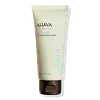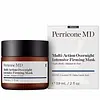What's inside
What's inside
 Key Ingredients
Key Ingredients

 Benefits
Benefits

 Concerns
Concerns

 Ingredients Side-by-side
Ingredients Side-by-side

Water
Skin ConditioningGlycerin
HumectantCaprylic/Capric Triglyceride
MaskingGlyceryl Stearate
EmollientCetearyl Alcohol
EmollientEthylhexyl Palmitate
EmollientPropanediol
SolventCetyl Alcohol
EmollientButyrospermum Parkii Butter
Skin ConditioningPEG-40 Stearate
EmulsifyingCeteareth-20
CleansingPhenoxyethanol
PreservativeXanthan Gum
EmulsifyingSorbitan Tristearate
EmulsifyingPropylene Glycol
HumectantUrea
BufferingCaprylyl Glycol
EmollientParfum
MaskingHexyl Cinnamal
PerfumingLimonene
PerfumingBenzyl Salicylate
PerfumingLinalool
PerfumingHydroxycitronellal
PerfumingLactic Acid
BufferingChlorphenesin
AntimicrobialSaccharide Hydrolysate
HumectantAlanine
MaskingGlycine
BufferingMagnesium Aspartate
Skin ConditioningSaccharide Isomerate
HumectantCreatine
Skin Conditioning1,2-Hexanediol
Skin ConditioningPotassium Sorbate
PreservativeSodium Benzoate
MaskingCitric Acid
BufferingSodium Citrate
BufferingSodium Hyaluronate
HumectantTocopherol
AntioxidantHelianthus Annuus Seed Oil
EmollientAloe Barbadensis Leaf Juice
Skin ConditioningAloe Barbadensis Leaf Extract
EmollientAllantoin
Skin ConditioningTocopheryl Acetate
AntioxidantMaris Sal
Skin ConditioningSilt
AbsorbentMaris Aqua
HumectantWater, Glycerin, Caprylic/Capric Triglyceride, Glyceryl Stearate, Cetearyl Alcohol, Ethylhexyl Palmitate, Propanediol, Cetyl Alcohol, Butyrospermum Parkii Butter, PEG-40 Stearate, Ceteareth-20, Phenoxyethanol, Xanthan Gum, Sorbitan Tristearate, Propylene Glycol, Urea, Caprylyl Glycol, Parfum, Hexyl Cinnamal, Limonene, Benzyl Salicylate, Linalool, Hydroxycitronellal, Lactic Acid, Chlorphenesin, Saccharide Hydrolysate, Alanine, Glycine, Magnesium Aspartate, Saccharide Isomerate, Creatine, 1,2-Hexanediol, Potassium Sorbate, Sodium Benzoate, Citric Acid, Sodium Citrate, Sodium Hyaluronate, Tocopherol, Helianthus Annuus Seed Oil, Aloe Barbadensis Leaf Juice, Aloe Barbadensis Leaf Extract, Allantoin, Tocopheryl Acetate, Maris Sal, Silt, Maris Aqua
Water
Skin ConditioningSqualane
EmollientCaprylic/Capric Triglyceride
MaskingIsopropyl Palmitate
EmollientCetearyl Alcohol
EmollientCocos Nucifera Oil
MaskingElaeis Guineensis Kernel Oil
EmollientDimethyl Mea
BufferingGlyceryl Stearate
EmollientPEG-100 Stearate
Citric Acid
BufferingThioctic Acid
AntioxidantPhosphatidylcholine
EmulsifyingEgg Shell Membrane Extract
PreservativeS-Palmitoylglutathione
AntioxidantButyrospermum Parkii Butter
Skin ConditioningAcetyl Tyrosine
Skin ConditioningXanthan Gum
EmulsifyingZinc Gluconate
Skin ConditioningMagnesium Aspartate
Skin ConditioningCopper Gluconate
Skin ConditioningDisodium EDTA
Dimethicone
EmollientCetearyl Glucoside
EmulsifyingCeteareth-20
CleansingCaprylyl Glycol
EmollientCetyl Alcohol
EmollientPhenoxyethanol
PreservativeSorbic Acid
PreservativeParfum
MaskingCitronellol
PerfumingBenzyl Benzoate
AntimicrobialHexyl Cinnamal
PerfumingLinalool
PerfumingWater, Squalane, Caprylic/Capric Triglyceride, Isopropyl Palmitate, Cetearyl Alcohol, Cocos Nucifera Oil, Elaeis Guineensis Kernel Oil, Dimethyl Mea, Glyceryl Stearate, PEG-100 Stearate, Citric Acid, Thioctic Acid, Phosphatidylcholine, Egg Shell Membrane Extract, S-Palmitoylglutathione, Butyrospermum Parkii Butter, Acetyl Tyrosine, Xanthan Gum, Zinc Gluconate, Magnesium Aspartate, Copper Gluconate, Disodium EDTA, Dimethicone, Cetearyl Glucoside, Ceteareth-20, Caprylyl Glycol, Cetyl Alcohol, Phenoxyethanol, Sorbic Acid, Parfum, Citronellol, Benzyl Benzoate, Hexyl Cinnamal, Linalool
Ingredients Explained
These ingredients are found in both products.
Ingredients higher up in an ingredient list are typically present in a larger amount.
This ingredient is also known as shea butter. It is an effective skin hydrator and emollient.
Emollients help soothe and soften your skin. It does this by creating a protective film on your skin. This barrier helps trap moisture and keeps your skin hydrated. Emollients may be effective at treating dry or itchy skin.
Shea butter is rich in antioxidants. Antioxidants help fight free-radicals, or molecules that may harm the body. It is also full of fatty acids including stearic acid and linoleic acid. These acids help replenish the skin and keep skin moisturized.
While Shea Butter has an SPF rating of about 3-4, it is not a sunscreen replacement.
Shea butter may not be fungal acne safe. We recommend speaking with a professional if you have any concerns.
Learn more about Butyrospermum Parkii ButterThis ingredient is an emollient, solvent, and texture enhancer. It is considered a skin-softener by helping the skin prevent moisture loss.
It helps thicken a product's formula and makes it easier to spread by dissolving clumping compounds.
Caprylic Triglyceride is made by combining glycerin with coconut oil, forming a clear liquid.
While there is an assumption Caprylic Triglyceride can clog pores due to it being derived from coconut oil, there is no research supporting this.
Learn more about Caprylic/Capric TriglycerideCaprylyl Glycol is a humectant and emollient, meaning it attracts and preserves moisture.
It is a common ingredient in many products, especially those designed to hydrate skin. The primary benefits are retaining moisture, skin softening, and promoting a healthy skin barrier.
Though Caprylyl Glycol is an alcohol derived from fatty acids, it is not the kind that can dry out skin.
This ingredient is also used as a preservative to extend the life of products. It has slight antimicrobial properties.
Learn more about Caprylyl GlycolCeteareth-20 is an emulsifier and cleansing agent. It is derived from cetearyl alcohol, a fatty alcohol.
As an emulsifier, Ceteareth-20 prevents oil and water from separating. It is also a surfactant. Surfactants help gather oil, pollution, and dirt to be washed away.
Cetearyl alcohol is a mixture of two fatty alcohols: cetyl alcohol and stearyl alcohol. It is mainly used as an emulsifier. Emulsifiers help prevent the separation of oils and products. Due to its composition, it can also be used to thicken a product or help create foam.
Cetearyl alcohol is an emollient. Emollients help soothe and hydrate the skin by trapping moisture.
Studies show Cetearyl alcohol is non-toxic and non-irritating. The FDA allows products labeled "alcohol-free" to have fatty alcohols.
This ingredient is usually derived from plant oils such as palm, vegetable, or coconut oils. There is debate on whether this ingredient will cause acne.
Due to the fatty acid base, this ingredient may not be Malassezia folliculitis safe.
Learn more about Cetearyl AlcoholCetyl Alcohol is a fatty alcohol. Fatty Alcohols are most often used as an emollient or to thicken a product.
Its main roles are:
Though it has "alcohol" in the name, it is not related to denatured alcohol or ethyl alcohol.
The FDA allows products labeled "alcohol-free" to have fatty alcohols.
Learn more about Cetyl AlcoholCitric Acid is an alpha hydroxy acid (AHA) naturally found in citrus fruits like oranges, lemons, and limes.
Like other AHAs, citric acid can exfoliate skin by breaking down the bonds that hold dead skin cells together. This helps reveal smoother and brighter skin underneath.
However, this exfoliating effect only happens at high concentrations (20%) which can be hard to find in cosmetic products.
Due to this, citric acid is usually included in small amounts as a pH adjuster. This helps keep products slightly more acidic and compatible with skin's natural pH.
In skincare formulas, citric acid can:
While it can provide some skin benefits, research shows lactic acid and glycolic acid are generally more effective and less irritating exfoliants.
Most citric acid used in skincare today is made by fermenting sugars (usually from molasses). This synthetic version is identical to the natural citrus form but easier to stabilize and use in formulations.
Read more about some other popular AHA's here:
Learn more about Citric AcidGlyceryl Stearate is a mix of glycerin and stearic acid.
It is used to stabilize the mixing of water and oil ingredients. By preventing these ingredients from separating, it can help elongate shelf life. It can also help thicken the product's texture.
As an emollient, it helps soften skin and supports barrier-replenishing ingredients.
In cosmetics, Glyceryl Stearate is often made from vegetable oils or synthetically produced.
This ingredient may not be fungal-acne safe
Fun fact: The human body also creates Glyceryl Stearate naturally.
Learn more about Glyceryl StearateHexyl Cinnamal is a fragrance ingredient with a similar scent to jasmine. It can be naturally found in chamomile essential oil.
This ingredient is a known EU allergen and may sensitize the skin. The EU requires this ingredient to be listed separately on an ingredients list.
Hexyl Cinnamal is not water soluble but is soluble in oils.
Learn more about Hexyl CinnamalLinalool is a fragrance and helps add scent to products. It's derived from common plants such as cinnamon, mint, citrus, and lavender.
Like Limonene, this ingredient oxidizes when exposed to air. Oxidized linalool can cause allergies and skin sensitivity.
This ingredient has a scent that is floral, spicy tropical, and citrus-like.
Learn more about LinaloolWe don't have a description for Magnesium Aspartate yet.
Parfum is a catch-all term for an ingredient or more that is used to give a scent to products.
Also called "fragrance", this ingredient can be a blend of hundreds of chemicals or plant oils. This means every product with "fragrance" or "parfum" in the ingredients list is a different mixture.
For instance, Habanolide is a proprietary trade name for a specific aroma chemical. When used as a fragrance ingredient in cosmetics, most aroma chemicals fall under the broad labeling category of “FRAGRANCE” or “PARFUM” according to EU and US regulations.
The term 'parfum' or 'fragrance' is not regulated in many countries. In many cases, it is up to the brand to define this term.
For instance, many brands choose to label themselves as "fragrance-free" because they are not using synthetic fragrances. However, their products may still contain ingredients such as essential oils that are considered a fragrance by INCI standards.
One example is Calendula flower extract. Calendula is an essential oil that still imparts a scent or 'fragrance'.
Depending on the blend, the ingredients in the mixture can cause allergies and sensitivities on the skin. Some ingredients that are known EU allergens include linalool and citronellol.
Parfum can also be used to mask or cover an unpleasant scent.
The bottom line is: not all fragrances/parfum/ingredients are created equally. If you are worried about fragrances, we recommend taking a closer look at an ingredient. And of course, we always recommend speaking with a professional.
Learn more about ParfumPhenoxyethanol is a preservative that has germicide, antimicrobial, and aromatic properties. Studies show that phenoxyethanol can prevent microbial growth. By itself, it has a scent that is similar to that of a rose.
It's often used in formulations along with Caprylyl Glycol to preserve the shelf life of products.
Water. It's the most common cosmetic ingredient of all. You'll usually see it at the top of ingredient lists, meaning that it makes up the largest part of the product.
So why is it so popular? Water most often acts as a solvent - this means that it helps dissolve other ingredients into the formulation.
You'll also recognize water as that liquid we all need to stay alive. If you see this, drink a glass of water. Stay hydrated!
Learn more about WaterXanthan gum is used as a stabilizer and thickener within cosmetic products. It helps give products a sticky, thick feeling - preventing them from being too runny.
On the technical side of things, xanthan gum is a polysaccharide - a combination consisting of multiple sugar molecules bonded together.
Xanthan gum is a pretty common and great ingredient. It is a natural, non-toxic, non-irritating ingredient that is also commonly used in food products.
Learn more about Xanthan Gum